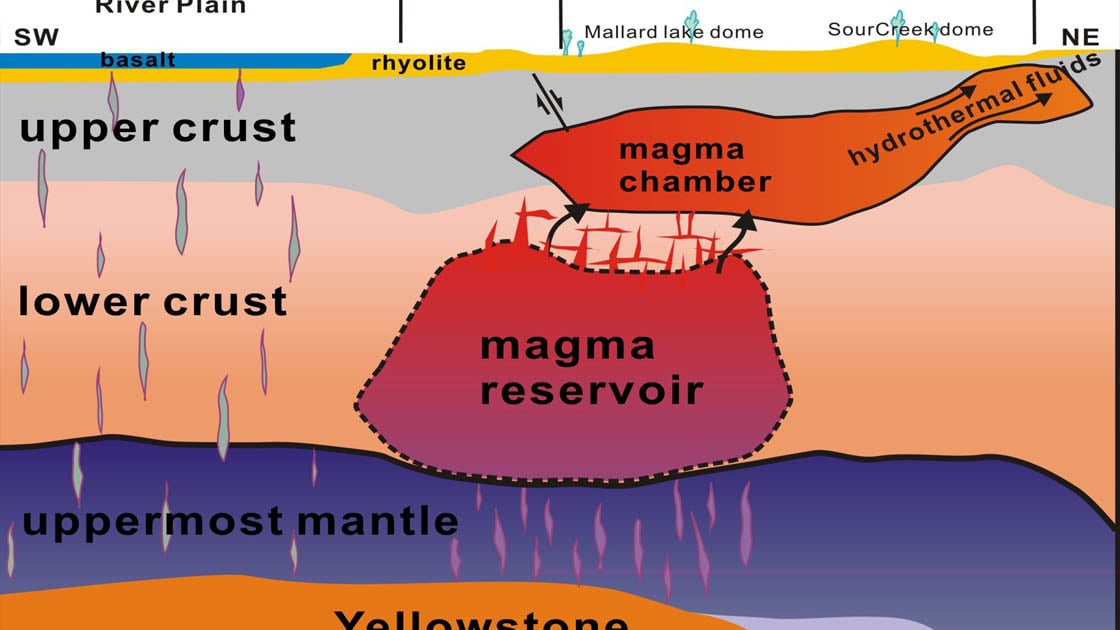Yellowstone Magma Reservoir: Uncovering Insights Into Future Volcanic Activity

Table of Contents
The Yellowstone Magma Reservoir: Size, Composition, and Location
Understanding the Reservoir's Dimensions
The Yellowstone Magma Reservoir is a vast and complex system, extending far beneath the Yellowstone Caldera. While precise dimensions are challenging to determine, scientific studies suggest a partially molten reservoir spanning tens of kilometers in diameter and extending several kilometers deep.
- Challenges in Mapping the Reservoir: The immense depth and the heterogeneity of the subsurface materials make mapping the reservoir's exact boundaries incredibly difficult. Geophysical techniques provide indirect evidence, and interpretation remains subject to uncertainties.
- Geophysical Techniques Used: Scientists use a variety of techniques to image the subsurface, including:
- Seismic tomography: Analyzing seismic waves to create 3D images of the Earth's interior.
- GPS: Measuring ground deformation to detect subtle changes indicating magma movement.
- Gravity and magnetic surveys: Mapping variations in the Earth's gravitational and magnetic fields to identify subsurface density and magnetic anomalies.
The Magma's Composition and Properties
The magma within the Yellowstone Magma Reservoir is predominantly rhyolitic, known for its high silica content and high viscosity. This makes it relatively slow-flowing, potentially leading to the buildup of pressure and more explosive eruptions compared to lower-viscosity basaltic magmas.
- Rhyolitic vs. Basaltic Magma: Rhyolitic magma is thicker and contains more dissolved gases than basaltic magma, influencing eruption style. Basaltic magma tends to produce more effusive eruptions (lava flows), while rhyolitic magma can lead to highly explosive events.
- Significance of Gas Pressure: Dissolved gases within the magma, primarily water vapor and carbon dioxide, play a critical role in driving eruptions. As pressure builds, these gases can trigger violent explosions.
Location and Geological Context
The Yellowstone Magma Reservoir is located beneath the Yellowstone Caldera, a large volcanic depression formed by past supereruptions. Its position is intimately tied to the Yellowstone hotspot, a plume of hot mantle material rising from deep within the Earth.
- Role of the Yellowstone Hotspot: The hotspot provides the heat source that drives magma generation and maintains the reservoir. The movement of the North American tectonic plate over the stationary hotspot explains the chain of volcanic activity across the western United States.
- Relationship with Hydrothermal Activity: The reservoir's heat fuels the abundant hydrothermal activity observed in Yellowstone National Park, including geysers, hot springs, and fumaroles. These features act as pathways for releasing heat and gases from the reservoir.
Monitoring Yellowstone's Volcanic Activity: Techniques and Observations
Seismic Monitoring
A dense network of seismographs constantly monitors earthquake activity around Yellowstone. Changes in seismic patterns, such as increased frequency or magnitude of earthquakes, can indicate magma movement or pressure changes within the reservoir.
- Seismic Wave Interpretation: Scientists analyze different types of seismic waves (P-waves, S-waves) to understand the location, depth, and size of seismic events.
- Recent Earthquake Activity: Yellowstone experiences thousands of small earthquakes annually, most too small to be felt. However, larger earthquakes provide valuable information about the underlying magmatic processes.
Ground Deformation Measurements
GPS and InSAR techniques measure subtle changes in the ground surface, providing crucial insights into magma movement and pressure fluctuations within the reservoir. Uplift or subsidence can indicate changes in the magma chamber's volume or pressure.
- Accuracy and Limitations: While these techniques are highly sensitive, they have limitations, particularly in terms of resolving the exact location and depth of magma movement.
- Observed Deformation Patterns: Long-term monitoring reveals patterns of ground deformation that are related to the underlying magmatic activity.
Geochemical Monitoring
The chemical composition of gases emitted from hydrothermal features provides valuable information about the state of the magma reservoir. Changes in the ratios of different gases (like CO2 and SO2) can indicate alterations in the magma's composition or pressure.
- Types of Gases Monitored: Scientists monitor various gases, including carbon dioxide (CO2), sulfur dioxide (SO2), and hydrogen sulfide (H2S), to detect changes in volcanic activity.
- Gas Composition as an Indicator: Increases in the concentration of certain gases can suggest a change in the magma’s pressure and a potential increase in volcanic activity.
Predicting Future Eruptions: Challenges and Probabilities
The Difficulty of Precise Prediction
Predicting volcanic eruptions, particularly at a supervolcano like Yellowstone, remains a significant challenge. The complexity of the system, the limitations of our monitoring techniques, and the inherent uncertainties in interpreting the available data make precise predictions extremely difficult.
- Uncertainties in Models: Current models rely on incomplete data and simplified representations of complex processes, leading to uncertainties in predictions.
- Limitations of Monitoring: While monitoring provides valuable information, it may not capture all the subtle changes occurring within the vast and complex Yellowstone Magma Reservoir.
Assessing the Risk
While the probability of a supereruption at Yellowstone within our lifetime is relatively low, it’s not zero. Scientists emphasize a long-term perspective, with timescales of thousands of years relevant for such events.
- Long-Term Perspective: The likelihood of a supereruption is much higher over geological timescales than over human timescales.
- Eruption Scenarios and Impacts: Different eruption scenarios exist, ranging from smaller, less impactful eruptions to catastrophic supereruptions. Each scenario has significantly different potential consequences for the surrounding region and the globe.
The Importance of Continued Research
Continued monitoring and research are crucial for improving our understanding of the Yellowstone Magma Reservoir and enhancing our ability to assess future volcanic hazards. Advances in monitoring technology and improved models are needed to refine eruption prediction capabilities.
- Ongoing Research Initiatives: Numerous research projects involve scientists from various disciplines studying various aspects of the Yellowstone volcanic system.
- Potential Advancements: Future advancements may include improved geophysical imaging techniques, advanced sensor technologies, and better predictive models incorporating diverse datasets.
Conclusion
Understanding the Yellowstone Magma Reservoir is a complex, ongoing scientific endeavor. This article highlighted the reservoir’s vast size, diverse magma composition, and the sophisticated monitoring techniques used to track its activity. While precise prediction of future eruptions remains challenging, ongoing research and advanced monitoring techniques are crucial to assessing the risks and informing preparedness strategies. The complexity of the system underscores the need for continued research. Learn more about the Yellowstone Magma Reservoir and stay updated on the latest research on Yellowstone's volcanic activity through reputable scientific sources and organizations like the USGS. Explore the ongoing efforts to understand the Yellowstone Magma Reservoir and contribute to informed discussions about this fascinating and potentially hazardous geological feature.

Featured Posts
-
 Gucci Re Motion White Gg Canvas Style Guide And Release Date May 2025
May 27, 2025
Gucci Re Motion White Gg Canvas Style Guide And Release Date May 2025
May 27, 2025 -
 Discover The Hottest Queer Music Renee Rapp St Vincent And More
May 27, 2025
Discover The Hottest Queer Music Renee Rapp St Vincent And More
May 27, 2025 -
 Ecb Den Faiz Artirimlarina Karsi Uyari Etkileri Ve Gelecek Beklentileri
May 27, 2025
Ecb Den Faiz Artirimlarina Karsi Uyari Etkileri Ve Gelecek Beklentileri
May 27, 2025 -
 Almanacco Di Oggi 23 Marzo Accadde Oggi Compleanni E Proverbio
May 27, 2025
Almanacco Di Oggi 23 Marzo Accadde Oggi Compleanni E Proverbio
May 27, 2025 -
 Wonder Park A Parents Guide To A Fun Filled Family Day
May 27, 2025
Wonder Park A Parents Guide To A Fun Filled Family Day
May 27, 2025
Latest Posts
-
 Ruuds French Open Campaign Ends With Knee Injury And Loss To Borges
May 30, 2025
Ruuds French Open Campaign Ends With Knee Injury And Loss To Borges
May 30, 2025 -
 Brooke Shields Reflects On Life Choices Children And Andre Agassi
May 30, 2025
Brooke Shields Reflects On Life Choices Children And Andre Agassi
May 30, 2025 -
 Steffi Graf Auf Instagram Diese Stars Folgen Ihr
May 30, 2025
Steffi Graf Auf Instagram Diese Stars Folgen Ihr
May 30, 2025 -
 Brooke Shields Book Reveals Regret Over Not Having Children With Agassi
May 30, 2025
Brooke Shields Book Reveals Regret Over Not Having Children With Agassi
May 30, 2025 -
 French Open 2025 Knee Injury Ends Ruuds Run Against Borges
May 30, 2025
French Open 2025 Knee Injury Ends Ruuds Run Against Borges
May 30, 2025
